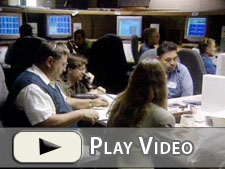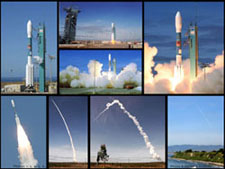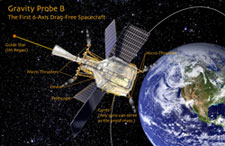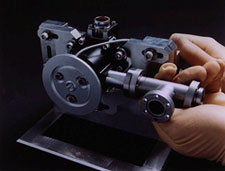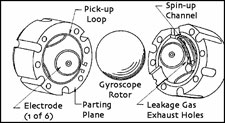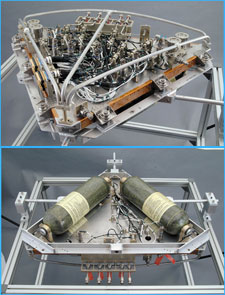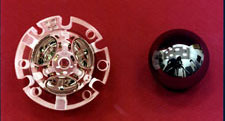Launch & Checkout
On this page:
Pre-launch Mission Operations Preparations
With a typical spacecraft, the mission operations team spends a considerable amount of time after launch learning how the spacecraft behaves and responds. Once the team has become comfortable operating the vehicle, the more sophisticated experimental operations are then attempted. In contrast, GP-B required that a number of very complex operations be carried out during the Initialization and Orbit Checkout (IOC) mission phase immediately following launch, because the dewar's lifetime was limited to approximately 16-17 months and a year's worth of experimental data had to be collected while there was still liquid helium in the dewar. With all of the unique features and cutting-edge technologies embodied in the GP-B spacecraft, it became apparent early on that the GP-B mission operations team would have to “hit the ground running.” To accomplish this goal, a sophisticated mission operations plan was created. Detailed procedures with contingencies, were developed, and the GP-B mission operations team went through rigorous training. One of the hallmarks of the GP-B mission operations team was “test it as you fly it, and fly it as you test it.” This meant that all of the ground test software and procedures used were essentially the same as those used in flight. The GP-B team also worked through a number of pre-launch simulations, with the test program being based on expected mission operations. Thus, by the time of launch, the team was already well-rehearsed and ready to tackle real issues and anomalies.
The GP-B Spacecraft Launch
The final GP-B launch date was set for Monday, April 19, 2004 from launch pad SLC-2W at Vandenberg Air Force Base (VAFB) on the central California coast. However, due to weather issues at the launch site, the launch had to be postponed for a day. Finally, on Tuesday, April 20, 2004 at 09:57:24 PDT, Principal Investigator Francis Everitt, Co-PI Bradford Parkinson, MSFC Program Manager Rex Geveden and a crowd of over 2,000 current and former GP-B team members and supporters watched and cheered as NASA launch commentator, George Diller, announced the final countdown:
"...five, four, three, two, main engines start, one...ignition...and LIFTOFF of the Delta II rocket carrying Gravity Probe B—testing for truth and the physics of our universe."
It was a flawless launch, with the Boeing Delta II 7920-10 rocket carrying the spacecraft into a cloudless sky. The Command/Control Computer Assembly (CCCA), Command and Data Handling (CDH) subsystem, and Attitude & Translation Control (ATC) electronics were powered on prior to launch, and command and telemetry links were established from the Mission Operations Center (MOC) at Stanford University when the fairing separated, five minutes after launch.
The Solar arrays deployed right on schedule, 66 minutes after launch, and the Boeing Delta II Launch Vehicle second stage released the Space Vehicle at the desired 642 km (400 mile) altitude, within 100 meters of a perfect orbit. Two on-board video cameras treated everyone watching the launch to a spectacular view of the spacecraft separating from the second stage rocket. The orbital insertion was so precise that no orbit trim was required during the Initialization and Orbit Checkout (IOC) phase of the mission.
That emotionally overwhelming day, culminating with the extraordinary live video of the spacecraft separating from the second stage booster, with a crescent of the Earth in the background, meant, as GP-B Program Manager Gaylord Green put it, "that 10,000 things went right!"
Initialization and On-Orbit Checkout (IOC)
Once the spacecraft was in orbit and communicating with the Mission Operations Center (MOC) at Stanford, the combined Stanford-NASA-Lockheed Martin Mission Operations team immediately set to work performing IOC initialization and checkout procedures. Activities during the IOC phase included:
- All subsystems that were not running during the launch were powered on and verified.
- The spacecraft’s Attitude and Translation Control (ATC) system was used for three main purposes:
- To properly orient the spacecraft, enabling the science telescope to lock onto the guide star, IM Pegasi.
- To establish and maintain the desired spacecraft roll rate.
- To fly the spacecraft in a drag-free orbit around one of the science gyros
- The science gyros were digitally suspended, and the SQUID magnetometer gyro readouts were tested.
- The spacecraft was balanced about its center of mass using the Mass Trim Mechanisms (MTMs) on the outside frame or shell of the spacecraft.
- The spacecraft’s roll rate was increased for a short time to uniformly wrap the bubble of superfluid liquid helium around the inside of the dewar wall.
- Using the Gyro Suspension System (GSS), many tests were made to calibrate the positions of the four science gyro rotors in their housings.
- In three spin-up stages, spread over a period of about a month, the spin rates of the gyros were gradually increased to their final science experiment levels, with many tests and calibrations performed at each stage.
- A Low-Temperature Bakeout (LTB) procedure was performed to remove stray helium molecules from within the gyro housings and science probe.
- The spin axes of the four gyros were aligned with the guide star,
- Electrostatic charging of each gyroscope was controlled throughout the period using an ultraviolet light discharge system.
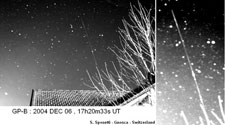
Photo of GP-B in orbit taken by Swiss
amateur astronomer, Stefano Sposetti
Prior to launch, the estimated time line for the IOC phase, based on many tests and simulations conducted at Stanford University and Lockheed Martin, was between 42 and 60 days—42 days of tasks, plus 18 days contingency. An additional 15 days contingency, if needed, was also budgeted into the overall mission time line. In the actual mission, IOC required a little over twice the amount of time originally anticipated.
Two main factors were responsible for most of the extension of the IOC phase of the mission:
- Tuning the ATC system to perform correctly—complicated by the loss of two micro thrusters and a commanded increase in the spacecraft roll rate to more than twice its originally anticipated value.
- Full-speed gyro spin-up and gyro spin axis alignment—complicated by the gyros spinning at less than half the anticipated full-speed rates.
Tuning the ATC System
GP-B is the first spacecraft ever launched with a requirement to control all 6 degrees of freedom of the vehicle. It requires three axes of rotational control—pitch, yaw, and roll—and it requires three axes of translational drag-free positioning. Many other spacecraft, like the Hubble Space Telescope, control pitch, yaw, and roll, but they do not roll continuously. Also, GP-B is only the second satellite ever launched to achieve 3-axis drag-free control. In retrospect, these requirements were more difficult to achieve on orbit than had been anticipated.
The initial IOC time line called for locking onto the guide star within the first four days in orbit. Successful locking onto the guide star was somewhat delayed due, in part, to the unexpected malfunction of two proportional helium-gas thrusters, which had to be identified, isolated, and taken out of service. These thrusters failed individually after two separate events: 1) launch, and 2) Science Instrument Assembly (SIA) flux flushing operations. Foreign particle contamination of the thruster mechanism is believed to be the likely root cause for both these failures. This problem was mitigated by revising the ATC software programming to perform with 14, instead of 16 thrusters and then uploading the revised software to the spacecraft’s on-board computer. (The remaining 14 thrusters performed flawlessly throughout the entire experiment.)
Another ATC-related issue that surfaced during the first orbit, concerned the spacecraft's two conventional star trackers and associated processing software, which had difficulty properly identifying star fields while the spacecraft was rolling continuously. This issue was formally declared Anomaly #5 by the team's Anomaly Review Board (ARB), and it was subsequently investigated and mitigated by a formal anomaly resolution process described in the section Resolving Anomalies and Managing Program Risks on the Mission Operations page. Furthermore, a decision to reduce noise in the experimental data signal by increasing the spacecraft’s roll rate from 0.52 rpm to 0.75 rpm (and ultimately, 0.774 rpm) made the ATC’s star field identification more difficult.
Spinning up the Gyroscopes
The most delicate and painstaking operations during the IOC phase concerned the four science gyros, for which there were no precedents in any other space mission. First, the gyro suspension system had to be checked out and calibrated for each of the four gyros. Then, the gyros were spun-up, one by one, by blowing a stream of pure helium gas through a spin-up channel in each rotor housing. The spin-up was accomplished gradually, in three stages that stretched over the month of July 2004. The spin-up operations were among the most stressful and risky of the entire mission.
Gyro #4, which showed the greatest spin-up helium leakage rate during low-speed testing was spun up to full speed first. The full-speed spin-up process, which lasted most of the day on 13 July 2004, went smoothly and resulted in a final spin rate of 105.8 Hz (6,348 rpm). Three days later, gyro #2 was spun up to full speed, also without incident. It reached a final spin rate of 87 Hz (5,220 rpm). Helium leakage from its spin-up caused gyro #4 to spin-down from 105.8 Hz to 91 Hz. While both of these spin rates were acceptable for the science phase, the team decided to postpone the full-speed spin-up of gyros #3 and #1 for a little over a week in order to run both ground-based and on-orbit tests, in an attempt to both increase the spin rates of the final two gyro rotors and also reduce the helium leakage during the spin-up process. During the last week in July, gyros #3 and #1 were spun up to full speed. Each of these gyro spin-ups caused approximately a 15% decrease in spin rate of the other gyros, resulting in the final gyro spin rates averaging 4,000 rpm, as shown in the table below.
| Final gyro spin rates | ||
|---|---|---|
| Gyro # | Final Spin Rate (Hz) | Final Spin Rate (rpm) |
| 1 | 80 | 4800 |
| 2 | 62.3 | 3738 |
| 3 | 82.7 | 4962 |
| 4 | 65.5 | 3930 |
Following gyro spin-up, it was necessary to “bake out” excess helium molecules remaining in the Probe from the spin-up gas. It was then necessary to align the spin axis of each gyro with the guide star—another set of painstaking procedures.
Aligning the Gyro Spin Axes
The final gyro spin rates were smaller than originally anticipated, but they were more than adequate for meeting the science requirements. However, these slower spin rates affected the process of spin axis alignment towards the end of the IOC period. Before beginning to collect spin axis precession data from the gyros, their spin axes initially had to be aligned with the guide star. This alignment was accomplished by the Gyro Suspension System (GSS), in conjunction with the SQUID magnetometer readouts, by applying small torques to the gyro rotors to “nudge” their spin axis positions into alignment with the direction of the guide star, as indicated by the telescope readout.
The spin axis alignment algorithm was designed with the assumption that the gyros would be spinning in the range of 120-170 Hz (7,200-10,200 rpm). At these very high spin rates, the gyro develops a significant centrifugal bulge, and the GSS uses this bulge as a “handle” for applying the torque to nudge the rotor’s spin axis. However, at slower spin rates, this centrifugal bulge is smaller than the natural out-of-round shape of the rotor, so the SQUIDs and GSS must apply the spin axis alignment torques to the natural, polhode-modulated, shape of the rotor, rather than the more predicable centrifugal bulge of fast spinning rotor. The torques generated under these circumstances were very small, and they required ground processing of rotor information and manual adjustment of the phasing and timing of the torque commands. Thus, it took more time to align the spin axes of the gyros when they are spinning slowly. In fact, the smaller the level of imperfections in the rotors, the longer it took the GSS to complete the alignment. As an example, gyro #4 is apparently so perfectly spherical that it took over two weeks longer than the other three gyros to align its spin axis.
Proton Bombardment and Other Contingencies
While ATC tuning, gyro spin-up, and spin axis alignment accounted for most of the IOC time extension, other contingencies contributed as well. One of the most serious anomalies of the mission occurred in the second week, when the spacecraft was passing over the Earth’s south magnetic pole and it was bombarded by proton radiation from the Sun. This radiation caused data errors in the spacecraft’s primary (A-side) computer, which exceeded its capacity for self-correction. By design, the spacecraft automatically switched over to the backup (B-side) computer, placed the spacecraft in a safemode, and put the planned timeline of events on hold. The automatic switch-over from primary to backup computer worked flawlessly. The GP-B mission operations team re-booted and re-loaded the A-side computer and then switched back to it, using up a few days of contingency time in the IOC time line.
Another unexpected issue that required a few days of contingency time to work through occurred at the very end of the IOC period. The spacecraft had entered back-up drag-free mode in preparation for the transition to the science phase of the mission. However, the team noticed that excess helium was being expended by the micro thrusters to maintain drag-free flight, and this ultimately led to the discovery of an unexpected force along the roll axis of the spacecraft. This force was analyzed over a period of approximately two weeks and some components of this force, which were attributed to thruster bias were countered. Ultimately, the ATC was tuned to work around this force without excess expenditure of helium.
Science Phase Trade-off Decision
Because the dewar was launched with enough superfluid helium to support a total mission time line of 16-18 months, the extra time required by IOC resulted in a trade-off decision: More optimization/calibration of the instrument prior to entering science, with a shorter data collection period; or, less optimization/calibration, with a longer data collection period. At that time, we concluded that the best overall accuracy would be achieved by ensuring the science instrument was optimally calibrated from the start, even if this meant collecting data for a shorter period than hoped. An added benefit of this decision is that we gained a considerably better understanding of the spacecraft subsystems and science instrument than was originally anticipated at that stage of the mission.
<- History and Management (Previous) | Mission Operations (Next) ->

